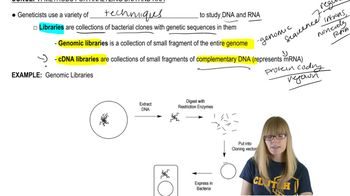Table of contents
- 1. Introduction to Genetics51m
- 2. Mendel's Laws of Inheritance3h 37m
- 3. Extensions to Mendelian Inheritance2h 41m
- 4. Genetic Mapping and Linkage2h 28m
- 5. Genetics of Bacteria and Viruses1h 21m
- 6. Chromosomal Variation1h 48m
- 7. DNA and Chromosome Structure56m
- 8. DNA Replication1h 10m
- 9. Mitosis and Meiosis1h 34m
- 10. Transcription1h 0m
- 11. Translation58m
- 12. Gene Regulation in Prokaryotes1h 19m
- 13. Gene Regulation in Eukaryotes44m
- 14. Genetic Control of Development44m
- 15. Genomes and Genomics1h 50m
- 16. Transposable Elements47m
- 17. Mutation, Repair, and Recombination1h 6m
- 18. Molecular Genetic Tools19m
- 19. Cancer Genetics29m
- 20. Quantitative Genetics1h 26m
- 21. Population Genetics50m
- 22. Evolutionary Genetics29m
18. Molecular Genetic Tools
Methods for Analyzing DNA
Problem 5c
Textbook Question
Using the genomic libraries in Problem 4, you wish to clone the human gene encoding myostatin, which is expressed only in muscle cells. How frequently will a clone representing myostatin be found in the genomic library made from brain?
 Verified step by step guidance
Verified step by step guidance1
Understand that a genomic library contains DNA fragments representing the entire genome of an organism, regardless of the tissue from which it was derived.
Recognize that myostatin is a gene expressed specifically in muscle cells, but its DNA sequence is present in all cells, including brain cells, because all cells contain the entire genome.
Consider that the genomic library made from brain cells will have DNA fragments that include the myostatin gene, even though it is not expressed in brain cells.
Estimate the frequency of finding a specific gene in a genomic library by considering the size of the genome and the average size of the DNA fragments in the library.
Calculate the probability of finding the myostatin gene in a clone by dividing the size of the human genome by the average size of the DNA fragments in the library, which gives the number of clones needed to represent the entire genome.
Recommended similar problem, with video answer:
 Verified Solution
Verified SolutionThis video solution was recommended by our tutors as helpful for the problem above
Video duration:
2mPlay a video:
Was this helpful?
Key Concepts
Here are the essential concepts you must grasp in order to answer the question correctly.
Genomic Libraries
Genomic libraries are collections of DNA fragments that represent the entire genome of an organism. These libraries are created by cloning DNA into vectors, allowing researchers to isolate and study specific genes. The composition of a genomic library can vary based on the tissue source, as different tissues express different sets of genes.
Recommended video:
Guided course

Genomics Overview
Gene Expression and Tissue Specificity
Gene expression refers to the process by which information from a gene is used to synthesize functional gene products, typically proteins. Tissue specificity indicates that certain genes, like myostatin, are expressed predominantly in specific tissues, such as muscle cells. This means that a genomic library derived from a non-expressing tissue, like the brain, is less likely to contain clones of genes that are not expressed in that tissue.
Recommended video:
Guided course

Penetrance and Expressivity
Cloning and Screening
Cloning involves inserting a DNA fragment into a vector to replicate it within a host organism, often bacteria. Screening is the process of identifying clones that contain the desired DNA sequence. In the context of a genomic library from the brain, the likelihood of finding a clone for myostatin is low, as the gene is not expressed in brain tissue, leading to fewer or no clones representing it.
Recommended video:
Guided course

Positional Cloning

 7:40m
7:40mWatch next
Master Methods for Analyzing DNA and RNA with a bite sized video explanation from Kylia Goodner
Start learningRelated Videos
Related Practice


